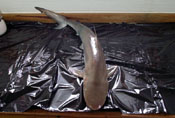http://www.fishbase.org/Summary/speciesSummary.php?genusname=Rhizoprionodon&speciesname=porosus ---> http://192.134.151.83/Summary/speciesSummary.php?genusname=Rhizoprionodon&speciesname=porosus
http://192.134.151.83/Summary/speciesSummary.php?genusname=Rhizoprionodon&speciesname=porosus ---> https://fishbase.mnhn.fr/Summary/speciesSummary.php?genusname=Rhizoprionodon&speciesname=porosus
https://fishbase.mnhn.fr/Summary/speciesSummary.php?genusname=Rhizoprionodon&speciesname=porosus ---> https://fishbase.mnhn.fr/summary/Rhizoprionodon-porosus.html
Rhizoprionodon porosus, Caribbean sharpnose shark : fisheries

You can
sponsor
this page
Common name (e.g. trout)
Genus + Species (e.g. Gadus morhua)
-

-
About this page
-
Languages
-
User feedbacks
-
Citation
-
Uploads
-
Related species
-


 Caribbean sharpnose shark
Add your observation in
Fish Watcher
Upload your
photos
and
videos
Caribbean sharpnose shark
Add your observation in
Fish Watcher
Upload your
photos
and
videos
Pictures
|
Google image
 Rhizoprionodon porosus
Rhizoprionodon porosus
Male picture by
Monzini, J.
Elasmobranchii (sharks and rays) >
Carcharhiniformes
(Ground sharks) >
Carcharhinidae
(Requiem sharks)
Etymology:
Rhizoprionodon:
rhiza
(Gr.), root;
prion
(Gr.) saw;
odon
(Gr.), tooth, referring to teeth with serrated (saw-like) bases, or roots [replacement name for
Rhizoprion
Ogilby 1915, preoccupied by
Rhizoprion
Jourdan 1861 in mammals]. (
See ETYFish
)
;
porosus:
Latin for pored or full of holes, referring to enlarged hyomandibular pores on both sides of head. (
See ETYFish
)
.
More on author:
Poey
.
Environment: milieu / climate zone / depth range / distribution range
Ecology
Marine; freshwater; brackish; reef-associated; depth range ? - 500 m (Ref.
244
), usually ? - 100 m (Ref.
244
). Tropical; 28°N - 40°S, 88°W - 32°W (Ref.
55194
)
Western Atlantic: Caribbean, including the Bahamas, south to Uruguay. The separation of this species from
Rhizoprionodon terraenovae
whether as a distinct species or a representative of a southern subspecies is still uncertain and pending until detailed studies are commenced.
Length at first maturity / Size / Weight / Age
Maturity: L
m
65.0
, range 80 - ? cm
Max length : 113 cm TL male/unsexed; (Ref.
111958
); common length : 75.0 cm TL male/unsexed; (Ref.
5217
); max. published weight: 7.5 kg (Ref.
111958
)
Common in bays and estuaries often entering rivers. Also found in offshore waters at depths of about 500 m, generally less than 100 m. Feeds mainly on small bony fishes, including wrasses, but also marine snails, squid and shrimp. Viviparous, with 2 to 6 young in a litter. Size at birth about 31 to 39 cm. Utilized salted or frozen for human consumption and processed into fish meal. Not dangerous (Ref.
9710
).
Distinct pairing with embrace (Ref.
205
). Viviparous, placental (Ref.
50449
).
Compagno, L.J.V.
, 1984. FAO Species Catalogue. Vol. 4. Sharks of the world. An annotated and illustrated catalogue of shark species known to date. Part 2 - Carcharhiniformes. FAO Fish. Synop. 125(4/2):251-655. Rome: FAO. (Ref.
244
)
IUCN Red List Status (Ref.
130435
)
Vulnerable (VU)
(A2d); Date assessed:
21 June 2019
CITES
Appendix II:
International trade monitored
Not Evaluated
Threat to humans
Harmless
Human uses
Fisheries: commercial
FAO - Publication:
search
| FIRMS -
Stock assessments
|
FishSource
|
Sea Around Us
More information
Countries
FAO areas
Ecosystems
Occurrences
Introductions
Stocks
Ecology
Diet
Food items
Food consumption
Ration
Common names
Synonyms
Metabolism
Predators
Ecotoxicology
Reproduction
Maturity
Spawning
Spawning aggregation
Fecundity
Eggs
Egg development
Age/Size
Growth
Length-weight
Length-length
Length-frequencies
Morphometrics
Morphology
Larvae
Larval dynamics
Recruitment
Abundance
BRUVS
References
Aquaculture
Aquaculture profile
Strains
Genetics
Electrophoreses
Heritability
Diseases
Processing
Nutrients
Mass conversion
Collaborators
Pictures
Stamps, Coins Misc.
Sounds
Ciguatera
Speed
Swim. type
Gill area
Otoliths
Brains
Vision
Tools
E-book
|
Field guide
|
Identification keys
|
Length-frequency wizard
|
Life-history tool
|
Point map
|
Classification Tree
|
Catch-MSY
|
Special reports
Check for Aquarium maintenance
|
Check for Species Fact Sheets
|
Check for Aquaculture Fact Sheets
Download XML
Summary page
|
Point data
|
Common names
|
Photos
Internet sources
AFORO (otoliths) |
Aquatic Commons
|
BHL
|
Cloffa
|
BOLDSystems
|
Websites from users
|
Check FishWatcher
|
CISTI
|
Catalog of Fishes
:
genus
,
species
|
DiscoverLife
|
ECOTOX
| FAO - Publication:
search
|
Faunafri
| Fishipedia |
Fishtrace
| GenBank:
genome
,
nucleotide
|
GloBI
|
GoMexSI
(interaction data)
|
Google Books
|
Google Scholar
|
Google
| IGFA World Record |
MitoFish
|
National databases
|
Otolith Atlas of Taiwan Fishes
|
PubMed
|
Reef Life Survey
| Socotra Atlas |
Tree of Life
| Wikipedia:
Go
,
Search
| World Records Freshwater Fishing |
Zoological Record
Estimates based on models
Preferred temperature (Ref.
123201
): 17.5 - 27.1, mean 24.2 °C (based on 80 cells).
Phylogenetic diversity index (Ref.
82804
): PD
50
= 0.5078 [Uniqueness, from 0.5 = low to 2.0 = high].
Bayesian length-weight: a=0.00214 (0.00141 - 0.00323), b=3.09 (2.97 - 3.21), in cm total length, based on LWR estimates for this species & Genus-body shape (Ref.
93245
).
Trophic level (Ref.
69278
): 4.0 ±0.2 se; based on diet studies.
Generation time: 3.7 ( na - na) years. Estimated as median ln(3)/K based on 2
growth studies.
Resilience (Ref.
120179
): Very Low, minimum population doubling time more than 14 years (Fec=2; K=0.3-0.42).
Fishing Vulnerability (Ref.
59153
): Moderate to high vulnerability (51 of 100).
Price category (Ref.
80766
):
Medium
.
Nutrients (Ref.
124155
): Calcium = 8.95 [1.65, 47.15] mg/100g; Iron = 0.433 [0.104, 1.231] mg/100g; Protein = 22.2 [19.3, 24.6] %; Omega3 = 0.143 [0.058, 0.338] g/100g; Selenium = 38 [11, 110] μg/100g; VitaminA = 58.9 [20.5, 179.1] μg/100g; Zinc = 0.758 [0.366, 1.514] mg/100g (wet weight);
Back to Search
Random Species
Back to Top
Accessed through:
Not available
FishBase mirror site :
localhost
Page last modified by :
mrius-barile
- 20 July 2016
Fatal error
: Uncaught ArgumentCountError: Too few arguments to function checkEcotox(), 1 passed in /var/www/html/summary/speciessummary.php on line 2304 and exactly 3 expected in /var/www/html/includes/speciessummary.lib.php:2579 Stack trace: #0 /var/www/html/summary/speciessummary.php(2304): checkEcotox() #1 {main} thrown in
/var/www/html/includes/speciessummary.lib.php
on line
2579
|